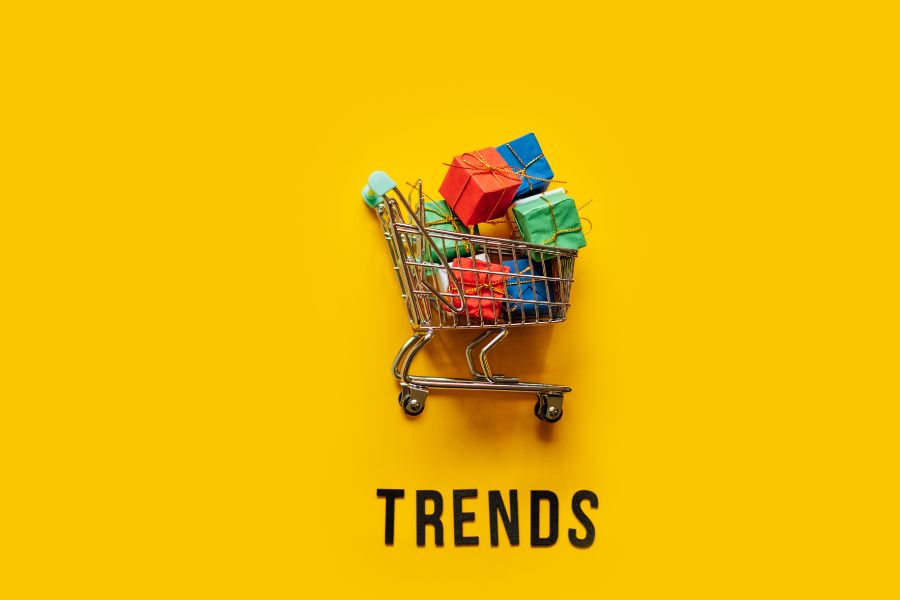Have you ever heard of the concept of the “endless aisle”? Currently, it has emerged as a promising strategy to expand product offerings and enhance the customer experience. However, with this approach comes a unique set of challenges that retailers must navigate to fully reap its benefits. In this blog post, we will give the key challenges of the endless aisle strategy and provide actionable insights on how retailers can overcome them to thrive in today’s competitive landscape.
What is an Endless Aisle?
An endless aisle refers to a retail strategy that allows customers to access a virtually unlimited assortment of products, even if they are not physically present in the store’s inventory or on display in the physical retail space. This concept leverages technology, such as digital kiosks, mobile apps, or online platforms, to enable customers to browse and purchase items that may not be available in-store at that moment.
Essentially, it extends the store’s inventory beyond its physical constraints, providing customers with a wider selection and enhancing their shopping experience. This approach can help retailers increase sales, reduce instances of out-of-stock products, and satisfy customer demand for variety and convenience.
Types of Endless Aisle Strategy
As you know, the definition of an endless aisle is in the first part. So, how many types does it have? Here are 3 endless aisle concepts for facilitating online orders for customers shopping in-store.
Interactive Kiosks
Interactive kiosks are self-service terminals placed within retail stores. They allow customers to browse a digital catalog of products that may not be physically available in the store.
Customers can explore various options, check product details, and place orders directly through the kiosk, enhancing their shopping experience and expanding the range of available products beyond what’s physically present in the store.
Showrooming
Showrooming involves customers visiting a physical store to examine products in person before making a purchase decision, but then ultimately buying the product online from the same retailer or a different one.
Retailers can capitalize on this behavior by providing in-store amenities like Wi-Fi access and mobile apps that facilitate seamless online purchasing. Thus, the showrooming experience can be transformed into an opportunity to capture sales that would otherwise be lost.
Order Fulfillment
Order fulfillment refers to the process of fulfilling customer orders for products that are not available in the store’s physical inventory. This can involve placing orders directly from the store for delivery to the customer’s preferred location, leveraging dropshipping arrangements with suppliers, or facilitating in-store pickup options for online orders.
By offering flexible order fulfillment options, retailers can meet customer demand for a wider range of products while optimizing inventory management and operational efficiency.
8 Risks of Endless Aisle Strategy in Retail and Its Overcome
Below are some of the typical challenges you should keep in mind when contemplating an endless aisle strategy:
Technical Integration
Implementing endless aisle solutions often poses technical integration challenges. Retailers may encounter difficulties integrating new systems with existing infrastructure, leading to compatibility issues, data synchronization errors, and disruptions in operations.
For example, connecting online ordering systems with in-store POS systems can be complex and prone to errors.
To overcome this challenge, retailers can invest in robust middleware solutions that facilitate seamless integration between different systems. Additionally, thorough testing and ongoing monitoring are essential to identify and address any technical issues promptly.
Inventory Transparency
Maintaining accurate inventory visibility across various channels is crucial for the success of endless aisle strategies. Discrepancies between online and in-store inventory can result in overselling or stockouts, and retailers may face difficulties in real-time inventory updates and tracking inventory movement across different locations.
To mitigate this issue, retailers can implement inventory management systems that offer real-time synchronization and centralized visibility. Utilizing barcode or RFID technology can enhance accuracy in inventory tracking, enabling retailers to provide customers with reliable stock information.
Employee Training and Adaptation
Introducing endless aisle solutions requires adequate training and adaptation among store employees. Challenges arise from the need to educate staff on new processes, technologies, and customer service protocols. Employees may struggle to navigate the complexities of online ordering systems or provide seamless assistance to customers using endless aisle services.
To prevent this, businesses should conduct comprehensive training programs that cover the use of technology, customer engagement techniques, and problem-solving skills. Providing ongoing support and incentives can motivate employees to embrace and excel in their roles within the endless aisle framework.
High Initial Setup Costs
The initial setup costs associated with implementing endless aisle solutions can be significant, including expenses related to software development, hardware installation, and infrastructure upgrades. Retailers may face budget constraints or uncertainties regarding the return on investment (ROI) of such investments.
To overcome this challenge, retailers can explore cost-effective options, such as cloud-based solutions or leveraging existing technology infrastructure where possible. Conducting thorough cost-benefit analyses and ROI calculations can help justify investment decisions and prioritize initiatives that offer the most value.
Supply Chain Management
Effective supply chain management is critical for ensuring seamless order fulfillment and inventory replenishment in endless aisle scenarios. Challenges may arise from coordinating with multiple suppliers, managing inventory across distributed locations, and optimizing logistics for timely deliveries.
Retailers can mitigate this by establishing strong partnerships with reliable suppliers and implementing robust inventory forecasting and replenishment strategies. Leveraging technology such as automated replenishment systems and supplier portals can streamline communication and collaboration within the supply chain, enhancing efficiency and reducing lead times.
Customer Service Consistency
Maintaining consistent customer service across various channels is essential for delivering a seamless shopping experience in endless aisle environments. Challenges arise from disparities in service quality between online and in-store interactions, leading to customer dissatisfaction and brand reputation damage.
The solution is implementing standardized service protocols and training programs that emphasize the importance of consistent service delivery. Utilizing omnichannel customer service platforms and feedback mechanisms enables retailers to monitor and address customer issues promptly, fostering trust and loyalty.
Efficient Handling of Returns and Exchanges
Efficient return and exchange handling is crucial for maintaining customer satisfaction and loyalty in endless aisle scenarios. Challenges may arise from processing returns for products ordered online but returned in-store, managing inventory restocking and refurbishment, and ensuring compliance with return policies.
Retailers can overcome this issue by implementing streamlined return processes supported by technology such as barcode scanning and automated return authorization. Clear communication of return policies and procedures to customers, along with dedicated staff training, can improve efficiency and consistency in handling returns and exchanges.
Data Security & Privacy
Protecting customer data and ensuring compliance with data security regulations are paramount in endless aisle implementations. Challenges may arise from vulnerabilities in online ordering systems, unauthorized access to customer information, and data breaches.
Retailers can address this by implementing robust cybersecurity measures, such as encryption, access controls, and regular security audits. Compliance with data protection regulations, such as GDPR or CCPA, requires implementing privacy policies, obtaining consent for data collection and processing, and providing transparency regarding data handling practices.
Educating employees and customers about data security best practices and promoting a culture of data privacy awareness can further enhance protection against security threats and mitigate risks of data breaches.
Leveraging ConnectPOS to Overcome Endless Aisle Challenges
Implementing an endless aisle strategy presents various challenges, such as technical integration, inventory management, and ensuring data security.
ConnectPOS, optimized for enhancing business performance with advanced technologies, offers robust solutions to these issues. Its seamless integration with retail systems ensures accurate inventory transparency and simplifies complex processes like order fulfillment and returns management. ConnectPOS’s user-friendly interface facilitates quick employee adaptation and training, reducing the impact of high initial setup costs. Additionally, it provides effective tools for supply chain management and maintains high standards of data security and privacy.
By adopting ConnectPOS, retailers can efficiently address the hurdles associated with Endless Aisle strategies, leading to improved operational efficiency and customer satisfaction.
FAQs: Endless Aisle Strategy
How can retailers improve inventory management in endless aisle strategies?
Retailers can enhance inventory management in endless aisle strategies by:
- Implementing efficient inventory tracking systems
- Utilizing real-time data analytics to predict demand
- Integrating inventory management software with online and offline sales channels
- Establishing clear communication channels between warehouses and stores
- Optimizing order fulfillment processes to minimize stockouts and overstock situations.
What is the endless aisle strategy?
The endless aisle strategy is a retail approach that leverages technology to expand product selection beyond what is physically available in-store. It allows customers to access a wider range of products, including items that may not be stocked on-site, through digital interfaces such as in-store kiosks, mobile apps, or online platforms.
This strategy aims to enhance customer satisfaction and increase sales by providing shoppers with a wider range of choices.
What is the main aisle in a store?
The main aisle in a store refers to the central pathway or thoroughfare that runs through the store, typically dividing it into distinct sections or departments.
It is the primary route that customers use to navigate the store and access different product categories. The main aisle is strategically designed to optimize traffic flow and promote visibility for featured products and promotional displays.
Wrap Up
In conclusion, the endless aisle strategy offers retailers an innovative approach to meet the evolving needs and preferences of today’s consumers. However, with careful planning, strategic investments, and a customer-centric mindset, retailers can overcome these challenges and unlock the full potential of the endless aisle strategy.
ConnectPOS leads this revolution with endless aisle strategy and automation features, helping online orders for customers shopping in-store. Feel free to reach out to us if you have any further questions or would like to explore endless aisle strategies in more detail.
ConnectPOS is a all-in-one point of sale solution tailored to meet your eCommerce POS needs, streamline business operations, boost sales, and enhance customer experience in diverse industries. We offer custom POS with features, pricing, and plans to suit your unique business requirements.




